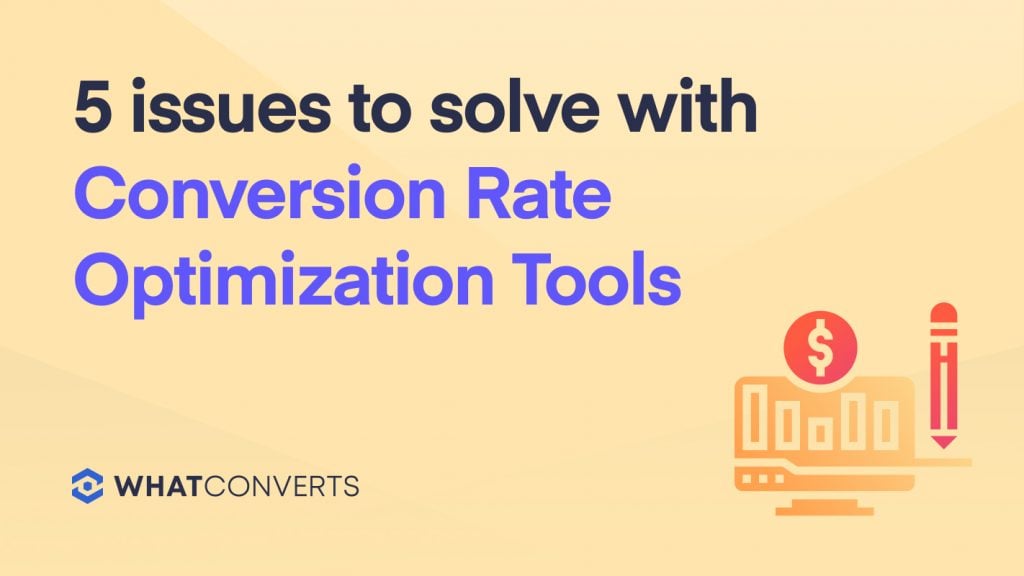
This is a guest post from Saher Shodan, CEO of Traktion.
Conversion rate optimization (CRO) is a hurdle most startups face as their venture grows. When there are inefficiencies in the conversion process, marketing funnels collapse and the company loses valuable customer relationships.
A conversion is a customer who visits your website and proceeds to take action such as filling out a form, placing a phone call or starting a web chat.
Major CRO Pain Points Your Organization Might Face
CRO is still widely misunderstood or written off as just another unnecessary business expense.
Most businesses don’t know how their marketing funnels work, why it’s important to qualify a lead, or have the ability to capture conversions through lead tracking and attribution.
In this article, we’ll outline four CRO pain points you might recognize, and then we’ll run through the corresponding strategies to fix these bottlenecks.
Pain Point #1: Conversion rate optimization tools are undervalued by management
Enterprises often casually assign “CRO duties” to a single employee. This is a strategic mishap that can hurt the company’s bottom-line over time.
CRO is not a one-person job, in fact, it requires multiple specialized skills ranging from copywriting to UX/UI design and analytical skills in statistics. The CRO manager must also be able to set up attribution systems and understand web development.
ConversionXL’s 2016 survey discovered that 49% of 722 respondents did not allocate anyone for CRO, whereas 29% stated that only one person did the job. This trend of not hiring qualified specialists for CRO duties results in low conversion rates for many companies.
How to fix this?
It is imperative that companies hire and source the right talent that understands the importance of identifying how marketing sources convert to leads, calls, and sales.
A 2013 survey by econsultancy found that 53% of companies spend less than 5% of their marketing budget on CRO. Marketing budget increases are often devoted to large-scale marketing campaigns or other top-of-funnel activities in brand-building and social media awareness campaigns.
However, with a proper understanding of CRO, companies do not know which channels provide them with the highest return on investment (ROI) in the first place.
As a marketer or CMO, you can convince management teams to increase budget allocation for CRO in the marketing mix. Opt to include an inhouse specialist or hire a pre-vetted expert freelancer that has a keen understanding of CRO.
Show how CRO can improve the bottomline through relevant case studies that showcase how end-to-end lead tracking allows the marketing team to understand which marketing channels are the most impactful for them. If an enterprise spends $100,000 on pay-per-click advertising (PPC), with a conversion rate of 1%, an increase of conversion rate from 2% will double company revenue.
Pain Point #2: Marketing teams lack data to adopt CRO
Marketing teams often do not have a thorough understanding of how to combine data sources to understand attribution.
As such, many marketers regard generic advice as the practice of CRO, such as changing website colors or call-to-action (CTA) buttons.
In order to understand how your leads are converting to clients, you need to have the data on where these leads are coming from, how they are progressing through your funnel, and whether it is a sales-qualified lead that is worth pursuing.
How to fix this?
Many marketing teams don’t have the data insights to power their CRO, because many don’t know how to plug different marketing channels into one consolidated customer relationship management (CRM) system.
It is vital to have a CRM system that encompasses lead tracking, lead management, a system of insights and analytics so you can understand where your customers are coming from and how they are responding to your marketing efforts.
Read on here to understand why CRM tools are important for marketing teams.
Pain Point #3: Companies do not have a proper sales qualification process
Many organizations don’t implement a documented framework to support CRO, according to ConversionXL. Part of this is the lack of a proper sales qualification process to identify marketing qualified leads (MQL), sales qualified leads (SQL) and junk leads.
Without a proper qualification process to separate bad leads and good leads, your sales team will not be able to prioritize their time and outreach plans properly.
How to fix this?
Companies should create a formal sales qualification framework, with a supporting system to enable sales and marketing teams to work in unison.
CRO needs to be understood by everyone in the organization, not just the members of the sales teams.
Companies need a platform that tracks and plans optimization activities, alongside additional layers that helps you understand the lead, such as the lead source and lead details. This will also ensure that everyone is on the same page about CRO activities, and what constitutes a SQL, MQL or a junk lead.
Pain Point #4: Organizations are resistant to change
It’s hard to implement large scale, holistic conversion rate optimization tools and structures in an organization when it requires breaking the status quo. The insights of CRO employees are considered less important than the insights of high-level managers, who can, at any point in the CRO process, ask for untested changes to be made according to their own personal preferences.
How to fix this?
To change the way an entire organization functions, businesses need to foster and create a culture of CRO in the organization.
This might be the hardest solution to implement because change often takes place slowly over time and is difficult to track. It is important to enlist the help of the top managers without making them feel like their power is being stripped away. A few ways to get them on board include:
- Presenting evidence-based research to prove the value of conversion rate optimization tools.
- Present competitive analyses and highlight the shortcomings of your current strategy which results in higher cost of acquiring customers.
- Show them the numerical benefits, for example by using a Return on Investment (ROI) analysis such as the one considered above.
- Calculate the true losses that can result if inexperienced executives make CRO decisions without prior testing.
Pain Point #5: Teams do not have a valid A/B testing process
Before increasing your budget, it’s important to identify which CRO practices actually work for your business through A/B testing.
A/B testing is a common CRO method where two or more side-by-side variations of the same web-page are shown to users in order to determine which one creates more conversions.
A/B tests are common, but the industry often grows too reliant on them.
Once you have set up your marketing mix properly with lead tracking and attribution, teams also need to understand the importance of doing A/B testing right.
How to fix this?
- Set up a proper framework for A/B testing through the following methods:
- Create testable hypotheses using data, and track this on a Kanban board
- Create A/B tests and other executable studies to see how well the new designs fare.
- Analyze the data from these tests through software like WhatConverts and use them again in further designs and research.
It All Comes Down To Understanding What Actually Works
In conclusion, you cannot actually improve your marketing conversion rate without understanding what is actually working. This is why management teams do not value CRO, and organizations are resistant to implementing conversion rate optimization tools.
It is thus essential to understand where your leads come from, see the quality of these leads, and identify the marketing channels that are most effective for you.
Get a FREE presentation of WhatConverts
One of our marketing experts will give you a full presentation of how WhatConverts can help you grow your business.
Schedule a Demo
Grow your business with WhatConverts






